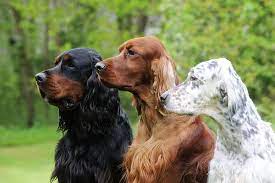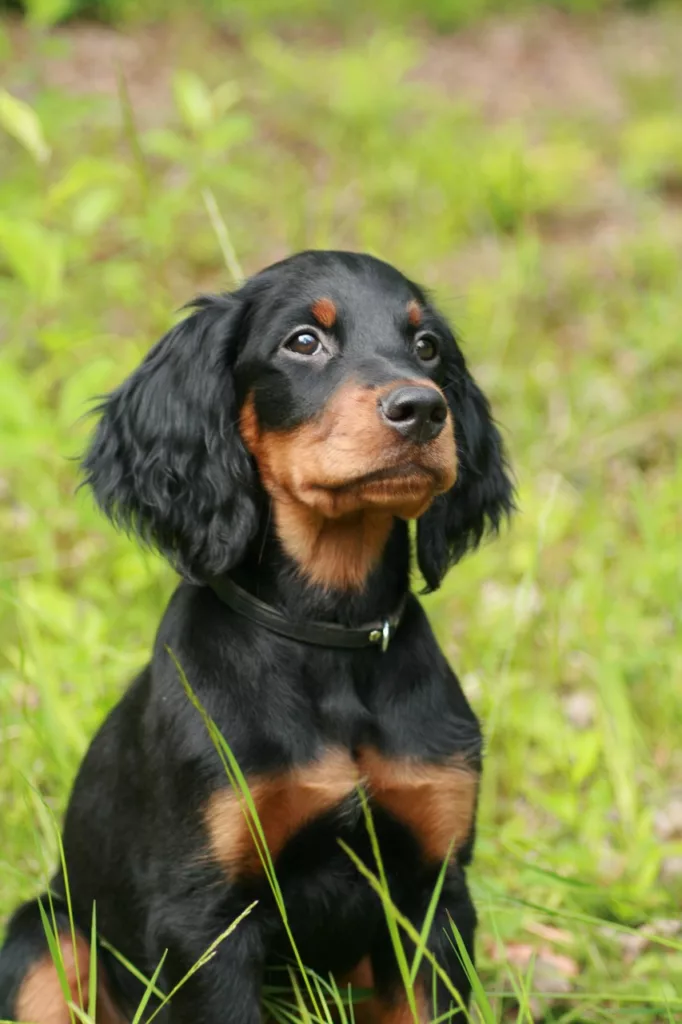The Gordon Setter is a majestic breed of dog known for its elegance, intelligence, and loyalty. This regal breed is one of the oldest setters, and its history dates back to the 1600s. Gordon Setters were originally bred in Scotland for hunting birds, and they are still prized for their keen sense of smell and hunting prowess. However, Gordon Setters are also wonderful companions, and they make excellent family pets.
Physical Characteristics
Gordon Setters are large dogs, with males standing 24-27 inches tall at the shoulder and weighing 55-80 pounds. Females are slightly smaller, standing 22-25 inches tall and weighing 45-65 pounds. They have a long, sleek coat that is typically black and tan, although other colors can also occur. The coat is moderately heavy, and it requires regular brushing to keep it free of tangles and mats.

Coat
The Gordon Setter’s coat is one of its most distinctive features. It is long and silky, with a moderate amount of feathering on the legs, chest, and tail. The coat is typically black with tan markings on the muzzle, chest, and legs. However, some Gordon Setters may have a liver or red coat instead of black. The coat is weather-resistant and helps protect the dog from harsh outdoor conditions.
Gordon Setters require regular grooming to keep their coat healthy and free of tangles. Weekly brushing is recommended, and more frequent brushing may be necessary during shedding season. Bathing should only be done as needed, as frequent bathing can strip the coat of its natural oils. Trimming around the feet and ears may also be necessary to maintain a neat appearance.
Body Structure
In addition to their beautiful coat, Gordon Setters have a distinct body structure that sets them apart from other breeds. They have a long, narrow head with a pronounced stop. Their eyes are dark brown and have a gentle expression. Their ears are long and drooping, framing their face and giving them a regal appearance.
Gordon Setters have a long, powerful neck and a deep chest, which allows them to have great stamina and endurance. Their legs are long and slender, giving them a graceful gait. Their feet are webbed, which makes them excellent swimmers. Gordon Setters also have a long, flowing tail that is typically carried low.
Temperament
Gordon Setters are intelligent, loyal, and affectionate dogs. They are gentle and loving with children, and they make excellent family pets. They are known for their calm and patient demeanor, making them great companions for families with young children. However, they do have a high energy level and require regular exercise to keep them happy and healthy.
Intelligence
Gordon Setters are highly intelligent dogs and excel in activities such as obedience, agility, and tracking. They are quick learners and enjoy being challenged mentally. This breed requires mental stimulation to prevent boredom and destructive behaviors. Training should be done with positive reinforcement methods, as they can be sensitive to harsh training techniques.

Loyalty
Gordon Setters are fiercely loyal to their owners and make excellent watchdogs. They are protective of their family and will alert them to any potential danger. However, they are not aggressive and will only use their size and bark as a means of protection. With proper socialization, Gordon Setters get along well with other animals and can even coexist with cats.
Affectionate
Despite their hunting background, Gordon Setters are affectionate and loving dogs. They thrive on human companionship and do not do well when left alone for long periods. They are known for their “velcro” tendencies, always wanting to be by their owner’s side. This makes them great therapy dogs and emotional support animals.
History
The Gordon Setter’s history can be traced back to the 1600s in Scotland. They were originally bred by the Duke of Gordon for hunting game birds such as grouse, pheasant, and quail. The breed was developed by crossing Scottish Setters with other breeds, including the Irish Setter and Bloodhound. The goal was to create a dog with a keen sense of smell, stamina, and an excellent hunting ability.
In the early 1800s, the breed became known as the Gordon Castle Setter, named after the Duke of Gordon’s estate. It wasn’t until the late 1800s that the breed was officially recognized as the Gordon Setter. The first Gordon Setter was imported to the United States in 1842, and the breed was recognized by the American Kennel Club in 1884.
Hunting Background
Gordon Setters were highly valued for their hunting abilities, specifically their keen sense of smell. They were used to hunt game birds in the rugged terrain of Scotland, where they needed to be able to navigate through dense brush and cover. Their long, slender legs and webbed feet made them excellent swimmers, allowing them to retrieve birds from water.
Today, Gordon Setters are still used for hunting, although their popularity as a companion and show dog has increased. They excel in field trials and have a strong drive to hunt and retrieve. However, it is essential to provide them with proper training and socialization to ensure they do not become overly focused on hunting.

Health Concerns
Like all breeds, Gordon Setters are prone to certain health conditions. Responsible breeders will screen their breeding stock for these conditions to reduce the risk of passing them on to offspring. Some common health concerns in Gordon Setters include:
- Hip Dysplasia: This is a condition where the hip joint does not develop correctly, leading to pain and mobility issues.
- Elbow Dysplasia: Similar to hip dysplasia, this condition affects the elbow joint and can cause lameness.
- Bloat: This is a life-threatening condition where the stomach fills with gas and twists on itself. It is more common in deep-chested breeds like Gordon Setters.
- Thyroid Disease: Gordon Setters are prone to hypothyroidism, a condition where the thyroid gland does not produce enough hormones.
- Progressive Retinal Atrophy (PRA): This is a degenerative eye disease that can lead to blindness.
It is essential to work with a reputable breeder who conducts health screenings on their breeding stock and provides proper care for their puppies. Regular vet check-ups and a healthy diet can also help prevent or manage these health conditions.
Training and Exercise
Gordon Setters are intelligent dogs and require mental stimulation to prevent boredom. They excel in activities such as obedience, agility, and tracking. They also make great hiking and running companions, as they have high energy levels and love to be outdoors.
Training
Training should begin early with Gordon Setters to establish good behaviors and manners. They respond well to positive reinforcement methods such as treats, praise, and playtime. Harsh training techniques should be avoided, as they can be sensitive to criticism. Consistency and patience are key when training a Gordon Setter.
Exercise
Gordon Setters require daily exercise to keep them physically and mentally stimulated. A long walk or jog, along with some playtime, will help burn off their excess energy. They also enjoy activities such as swimming, hiking, and retrieving games. Without proper exercise, Gordon Setters may become destructive or develop behavior problems.
Video
Conclusion
In conclusion, the Gordon Setter is a majestic breed of dog with a rich history and many admirable qualities. From its elegant appearance to its intelligence and loyalty, it is no wonder this breed has captured the hearts of many. Whether as a hunting companion or a family pet, the Gordon Setter is sure to bring joy and love into any home. With proper care, training, and exercise, this regal breed will continue to thrive for many years to come.